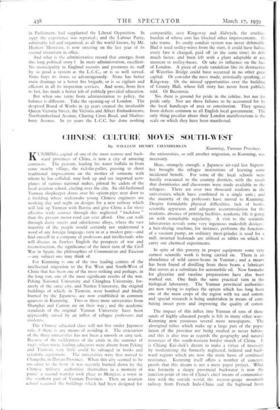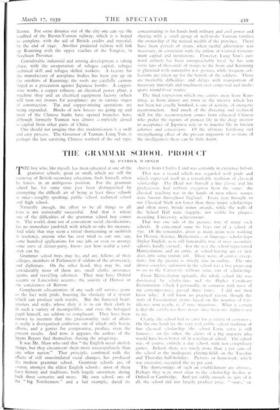CHINESE CULTURE MOVES SOUTH-WEST
By WILLIAM HENRY CHAMBERLIN
Kunming, Yunnan Province.
KUNMING, capital of one of the most remote and back- ward provinces of China, is now a city of amazing contrasts. The peasant, leading his water buffalo in from some nearby village, the ricksha-puller, pausing to shout traditional imprecations on the mother of someone with whom he has collided, may look up and see imported aero- planes of various national makes, piloted by cadets of the local aviation school, circling over the city. An old-fashioned Yunnan shopkeeper dozes over his opium-pipe next door to a building where widcawake young Chinese engineers are working day and night on designs for a new railway which will link up Yunnan with Burma and give China a far more effective trade contact through this neglected " backdoor " than the present motor-road can ever afford. One can walk through dusty streets and odoriferous alleys, where the vast majority of the people would certainly not understand a word of any foreign language, turn in at a modest gate—and find oneself in a company of professors and intellectuals who will discuss in flawless English the prospects of war and reconstruction, the significance of the latest turn of the Civil War in Spain, the philosophies of Communism and Fascism —any subject one may think of.
For Kunming is one of the two leading centres of the intellectual migration to the Far West and South-West of China that has been one of the most striking and perhaps, in the long run, one of the most significant results of the war. Peking National University and Chinghua University, for- merly of the same city, and Nankai University, the original buildings of which, in Tientsin, were bombed and finally burned by the Japanese, are now established in common quarters in Kunming. Two or three more universities from Shanghai and Canton are on their way ; and the academic standards of the original Yunnan University have been appreciably raised by an influx of refugee professors and students.
The Chinese educated class will not live under Japanese rule, if there is any means of avoiding it. The evacuation of the three universities has not been a smooth or easy task. Because of the suddenness of the crisis in the summer of 1937, when many leading educators were absent from Peking and Tientsin, very little could be salvaged in books and scientific equipment. The universities were first moved to Changsha, in Hunan Province. When this city seemed to be too close to the front (it was recently burned down by the Chinese military authorities themselves in a moment of panic) a second transfer took place to Mongtze, a town in the southern part of Yunnan Province. Then an aviation school required the buildings which had been designed for the universities, so still another migration, to Kunming, was necessary.
Here, strangely enough, a Japanese air-raid last Septem- ber brought the refugee institutions of learning some incidental benefit. For some of the local schools were hastily evacuated to the country districts, with the result that dormitories and classrooms were made available to the refugees. There are over two thousand students in the universities, which have combined in a single unit ; and the majority of the professors have moved to Kunming. Despite formidable physical difficulties, lack of books. scientific apparatus and adequate accommodation for the students, absence of printing facilities, academic life is going on with remarkable regularity. A visit to the scientific laboratories reveals some very ingenious makeshift devices: a hair-drying machine, for instance, performs the functions of a vacuum pump, an ordinary meat-grinder is used for a mill, inverted bedsteads are utilised as tables on which to carry out chemical experiments.
In spite of this poverty in proper equipment some very earnest scientific work is being carried on. There is an abundance of wild castor-beans in Yunnan ; and a means has been found of distilling from these beans a lubricant that serves as a substitute for automobile oil. New formulas for glycerine and vaseline preparations have also been worked out. One finds the same practical turn in the biological laboratory. The Yunnan provincial authorities are now trying to replace the opium which has long been one of the main crops of the region with tea and cotton. and special research is being undertaken in means of com- bating insect pests and improving the quality of cotton.
The impact of this influx into Yunnan of tens of thou- sands of highly educated people is felt in many other ways. Kunming now possesses several more newspapers. The aboriginal tribes which make up a large part of the popu- lation of the province are being studied as never before; and this is also true as regards the geography and natural resources of this south-western border march of China. It is Chiang Kai-shek's dream to make a virtue of necessity by modernising the formerly neglected, isolated and back- ward regions which are now the main bases of continued resistance. Kunming itself offers a number of concrete proofs that this dream is not a mere paper project. What was formerly a sleepy provincial backwater is now the junction-point of two of China's chief means of communica- tion with the outside world, the narrow-gauge mountain railway from French Indo-China and the highroad from Burma. For some distance out of the city one can see the roadbed of the Burma-Yunnan railway, which it is hoped to complete, with the aid of British credits and material, by the end of 1941. Another projected railway will link up Kunming with the upper reaches of the Yangtze, in Szechuen Province.
Considerable industrial and mining development is taking place, with the co-operation of refugee capital, refugee technical skill and refugee skilled workers. A factory for the manufacture of aeroplane bodies has been put up on the outskirts of Kunming; the roofs are carefully camou- flaged as a precaution against Japanese bombs. A copper- wire works, a copper refinery, an electrical power plant, a machine shop and an electrical equipment factory (which will turn out motors for aeroplanes) are in various stages of construction. Tin and copper-mining operations are being expanded. Blocks of new houses are going up and most of the Chinese banks have opened branches here, although formerly Yunnan was almost completely closed to capital from other parts of China.
One should not imagine that this modernisation is a swift and easy process. The Governor of Yunnan, Lung Yun, is perhaps the last surviving Chinese warlord of the old type,
concentrating in his hands both military and civil power and sharing with a small group of well-to-do Yunnan families the ownership of the natural wealth of the province. There have been periods of strain, when tactful adjustment was necessary, in connexion with the inflow of Central Govern- ment capital and institutions. However. Lung Yun's out- ward attitude has been unimpeachably loyal: he has sent some tens of thousands of troops to the front and Kunming is plastered with nationalist war posters, while frequent col- lections are taken up for the benefit of the soldiers. There are inevitable difficulties and delays with transportion of necessary materials and machinery over congested and inade- quate roundabout routes.
The final impression which one carries away from Kun- ming, as from almost any town in the interior which has not been too cruelly bombed, is one of activity, of energetic reconstruction. And much of the directing and technical skill for this reconstruction comes from educated Chinese who prefer the rigours of pioneer life in the deep interior to acceptance of Japanese rule or to inactive life in foreign colonies and concessions. Of the ultimate fertilising and strengthening effect of the present migration of so many of the intelligentsia there can be little doubt.











































 Previous page
Previous page